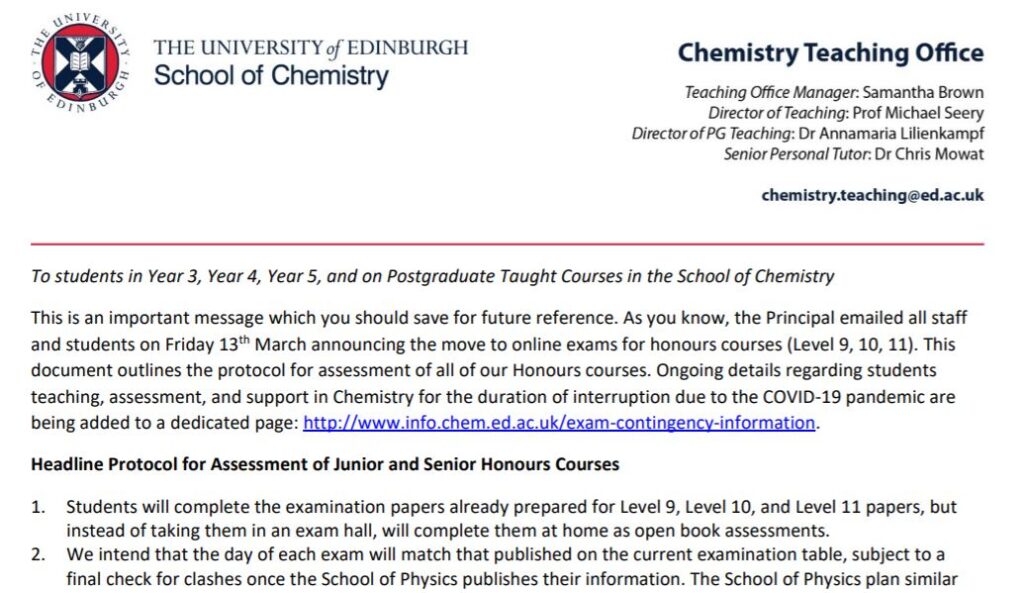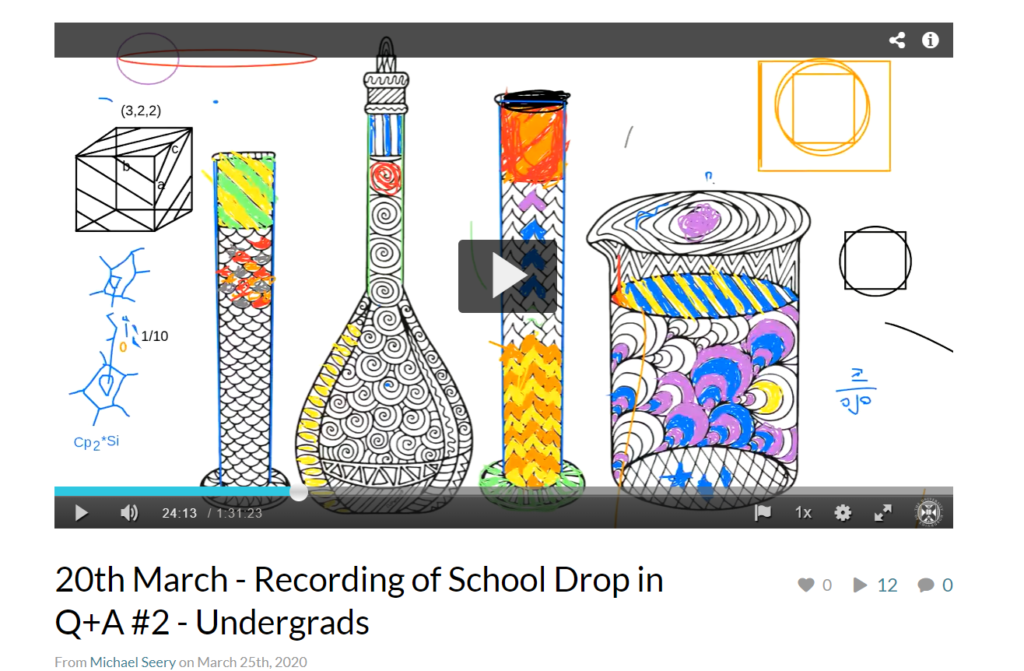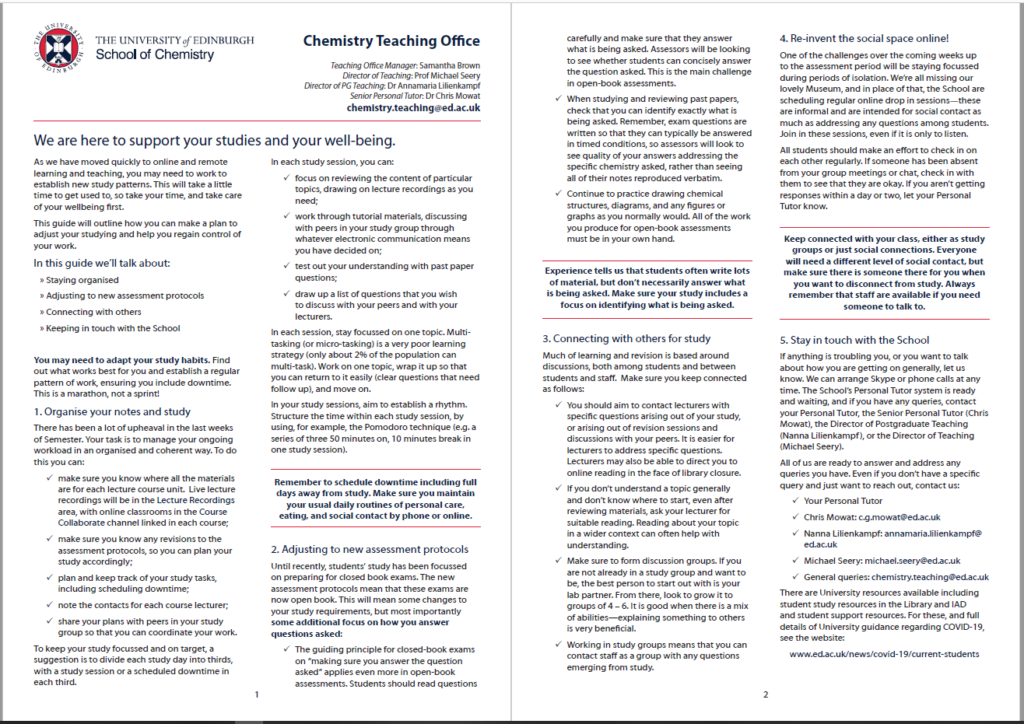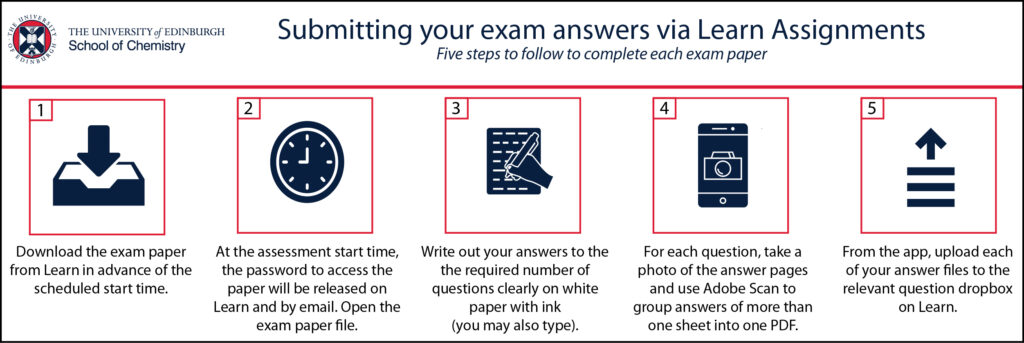
In this ‘Spotlight on remote teaching’ post, Professor Michael Seery, Director of Teaching, and Dr Chris Mowat, Senior Personal Tutor, share five approaches they have developed along with colleagues in the School of Chemistry to help students manage the increase in communications, the changing nature of academic and personal support, and how to approach assessments during Covid-19…
The end of academic year is a busy time for students in normal circumstances, but this year, in addition to spending this time reviewing all of their courses and getting ready for assessment, there is a swell in information relating to managing alternative arrangements due to COVID-19 that our honours students have to process. As a combined effort, we have been working to mediate this information in a way that is clear, coordinated, and student-focussed. We share below five headline strategies that are working well for us, what we are doing next, and reflect on how the last few weeks have been.
1. The “Mega-Emails”
Student email boxes are busy at the best of times with university communications, but obviously at the moment there are some really important emails coming from the Principal and Vice-Principal at University level and from both of us at School level regarding revised arrangements, new protocols and processes, etc. These are in a sea of important but “for noting” emails also being sent. To help students have easy access to the key information circulated in what one student has called “The Mega-Emails”, we produce single page documents compiling key messages from various emails circulated from the perspective of chemistry students. We host these (and indeed all the activities mentioned on this post) on a single “contingency” intranet page that all Learn courses link to. This means that there is a single source for students that they can go to that they know has all of the important information summarised specifically for School of Chemistry students.

2. Managing student support via the Personal Tutor System
Like all Schools, we have a well-run Personal Tutor system that underpins our established formal (and informal) staff-student networks. After the move to remote teaching, our immediate tasks included briefing personal tutors on changing circumstances and headline guidance, so that they were able to answer headline technical queries (regarding assessments, etc.), and also be aware of the many new types of requests that were emerging. We gave some typical scenarios and responses, such as students wondering whether they could go home, students who were on a Year Abroad and unsure of whether to stay or leave, etc. Chris has elaborated on these support aspects in his own blog.
We also wanted to emphasise to students that we were expecting them to contact us, and, moreover, we wanted them to contact us – we knew there would be queries and concerns and we wanted to address them. We saw hesitation among students as they were writing emails with opening lines including statements such as “sorry for bothering you at this busy time…” If some students were thinking that they were “bothering” us, we were worried that some might not be reaching out at all. To this end, we adopted a few tactics. A simple one was to include a standard line in all of our correspondence:
If anything is troubling you, or you want to talk about how you are getting on generally, let us know. We can arrange Skype or phone calls at any time. The School’s Personal Tutor system is ready and waiting, and if you have any queries, contact your Personal Tutor, the Senior Personal Tutor (Chris Mowat), the Director of Postgraduate Teaching (Nanna Lilienkampf), or the Director of Teaching (Michael Seery). All of us are ready to answer and address any queries you have. Even if you don’t have a specific query and just want to reach out, contact us.
3. Supporting ongoing dialogue during isolation
A second tactic to reach out to students was to schedule Q&A webchats, which we have been holding twice-weekly. We run these through Collaborate, and they are scheduled for a time (Mondays and Thursdays at noon) and place where students can connect and ask questions. The nature of these varies from managing lots of queries (usually after a “Mega Email”) to discussing the pets of students and staff attending the chat. They have an important social, as well as academic, context, and go a long way to preserving a sense of belonging to the School community among physically distant people. We record the chats and make them available on a dedicated Media Hopper channel. Chris has elaborated more on this in a blog post.

4. Getting students’ focus back to study
Of course with everything going on, both in terms of university changes and the huge daily news-media load, a challenge for students has been to focus on study. We wanted to try and create a “new normal”, whereby we returned students’ focus to chemistry, and tried to help them structure that time. In addition, preparing for open-book assessments requires a different type of study, so we wanted to be clear to students what that looked like. We created a short guide to studying for open book assessments, and, as well as being a document in its own right, it supports the consistent messaging across the school to students on what they should be doing and how they should be doing it. We’ve heard a lot of chat from students about difficulty to focus, and activities like this will hopefully help. Full details of this, as well as the text we’ve included, is available on Michael’s blog if you want to reuse in your own setting.

5. Making clear what the finish-line looks like
Students have a good conception of what an exam hall setting looks and feels like, and we wanted to replicate that awareness for the new arrangements. Aware of the text-heavy nature of a lot of communications, we made a video explaining how the open-book assessment protocol will work for students, how they should get access to their exam paper, and how they upload their answers. This is nothing beyond what they are used to normally in using Learn, but the intention was to describe to them, in a non-text based way, how the whole process works. Details of the video and the technical aspects of how we are managing the assessment process behind the scenes are available on Michael’s blog.

We’ve complemented this with a text-based instruction – a simple sheet just detailing the five steps involved – and made a mock-Learn site where students can practice using the assessment upload interface.
What’s next?
Right now, we are working on guidance for students on what that 48 hours is going to look like, so that we can elaborate on how can they manage it so that they stay well, perform as well as they can, and comply with any regulations that are set relating to them. We’re also working on some career guidance webinars and discussions around things like CV clinics, interview strategies, and, in collaboration with the Careers Service, navigating the current uncertainty from a careers perspective. The task ahead is to keep engaging fully with students as they progress, either onto the next year of study, or on and out into the next stage of their lives. We’ve also been thinking back on the last few weeks as we look forward to contingency efforts for the next stage:
Our reflections
Chris’ reflections:
In a strange sense, it’s something of a relief to be at the stage we are now. The uncertainty of what would happen, and when it might happen, was stressful, and being able to act effectively as a team to support our students is incredibly fulfilling. I have always been confident in the strength of our staff-student relationships, and proud of our sense of community, but it has never been tested like this. Students and staff alike have made the best of a surreal and difficult situation with good humour and patience. The gratitude shown by students has been humbling, and I’m looking forward to seeing them, and colleagues, in person once this all has passed. In the meantime, we’ll just keep supporting each other in whatever ways possible.
Michael’s reflections:
It’s been a roller-coaster few weeks, but just been fantastic to see everyone come together. Everything we’ve asked of colleagues has had the response: “yes, no problem”. Students have been fantastic; I am just continually impressed by their adaptability and resilience and work ethic through all of the changes. It has been encouraging to receive notes of thanks from them, and we even heard that over 100 students wrote to the Principal to thank him for the work being done in Chemistry. That’s definitely a morale boost for all the staff here, but more importantly tells me we are doing the right thing by them. While this is my job, seeing how hard students are working to just get on with things makes me want to reciprocate and work hard to help them as much as we can.
Note: We both wish to acknowledge the substantial amount of work done by our colleagues that have contributed to the activities described above. It has been a whole-School effort, but we particularly acknowledge Dr Annamaria (Nanna) Lilienkampf, our Director of Postgraduate Studies, who is leading the work with our PGT students, our Teaching Office and IT team colleagues who make all of these things happen in practice, and our Head of School.
Other USEFUL RESOURCES:
- Information Services Teaching Continuity web pages
- New guidance for students on using online learning tools
- Assessment Continuity webpages on the Information Services website



